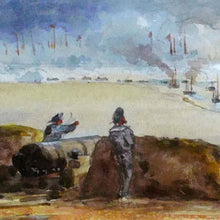Second Opium War - The Battle of Escape Creek, 1857
- Regular price
- £1,850
- Sale price
- £1,850
- Regular price
-
- Unit price
- /per
Adding product to your cart
Overall: 36cm (14.2in) x 52cm (20.5in)
Exhibited: Martyn Gregory, 'Jubilee Exhibition of China Trade Paintings’, 2002.
Provenance: Collection of Roger Moss, O.B.E.
Pencil and watercolour on paper. English school. British tars looking up stream from a captured fort on the East River during the pursuit and destruction of Qing Chinese war junks on 25 May 1857. Signed in monogram lower left 'G.D.T'. Sheet: 17cm x 29.5cm.
An episode from the Opium War of 1856-60, the Battle of Escape Creek. Commodore Charles Elliot's squadron followed the enemy war-junks the creek and as the river narrowed, continued the pursuit in the ships' boats until all the junks had been overhauled.
Read more
On 25 May 1857, Elliot went on board the tender Hongkong, and, followed by the gunboats Bustard, Lieutenant Tathwell Benjamin Collinson, Staunch (The Staunch seems to have subsequently fallen astern.), Lieutenant Leveson Wildman, and Starling, Lieutenant Arthur Julian Villiers, and the tender Sir Charles Forbes, in the order named, towing boats manned from the Sibylle, Raleigh, Tribune, Hornet, Inflexible, and Fury, steamed into the creek, and soon sighted 41 junks, which were moored across the stream, and which opened a spirited fire from their guns - in each case a 24- or 32-pr. forward, and four or six 9-prs. The attacking craft then formed in line in as wide order as possible, and replied warmly, the Chinese sticking to their guns wonderfully well, but finally cutting their cables, hoisting their sails, getting out their sweeps, and fleeing further up. The steamers pursued until they grounded; and then their people abandoned them temporarily, and, jumping into the boats, pulled hard after the enemy. One by one, several of the junks were overhauled. In most cases the Chinese, when a boat got alongside, fired a last broadside of grape and langridge at her, leapt overboard on the other side, and swam for shore. Thus sixteen craft were disposed of in the main channel, by boats led by Captain Harry Edmund Edgell, of the Tribune, 31, screw. Ten more took refuge up a minor creek on the left, and were chased by a division of boats under Commander Charles Codrington Forsyth; whereupon their crews set them on fire and abandoned them. One vessel, which made for a creek on the right, was abandoned so hastily that her people had no time to fire her; and she was taken and towed out. The other junks got away by dint of hard pulling. The heat was terrible, and, although there were only two casualties from the enemy's shot, some damage was done by sunstroke.
An etched version of the present picture appears in George Wingrove Cooke’s ‘Times’ Special Correspondence from China in the Years 1857-58’, published in 1858.






